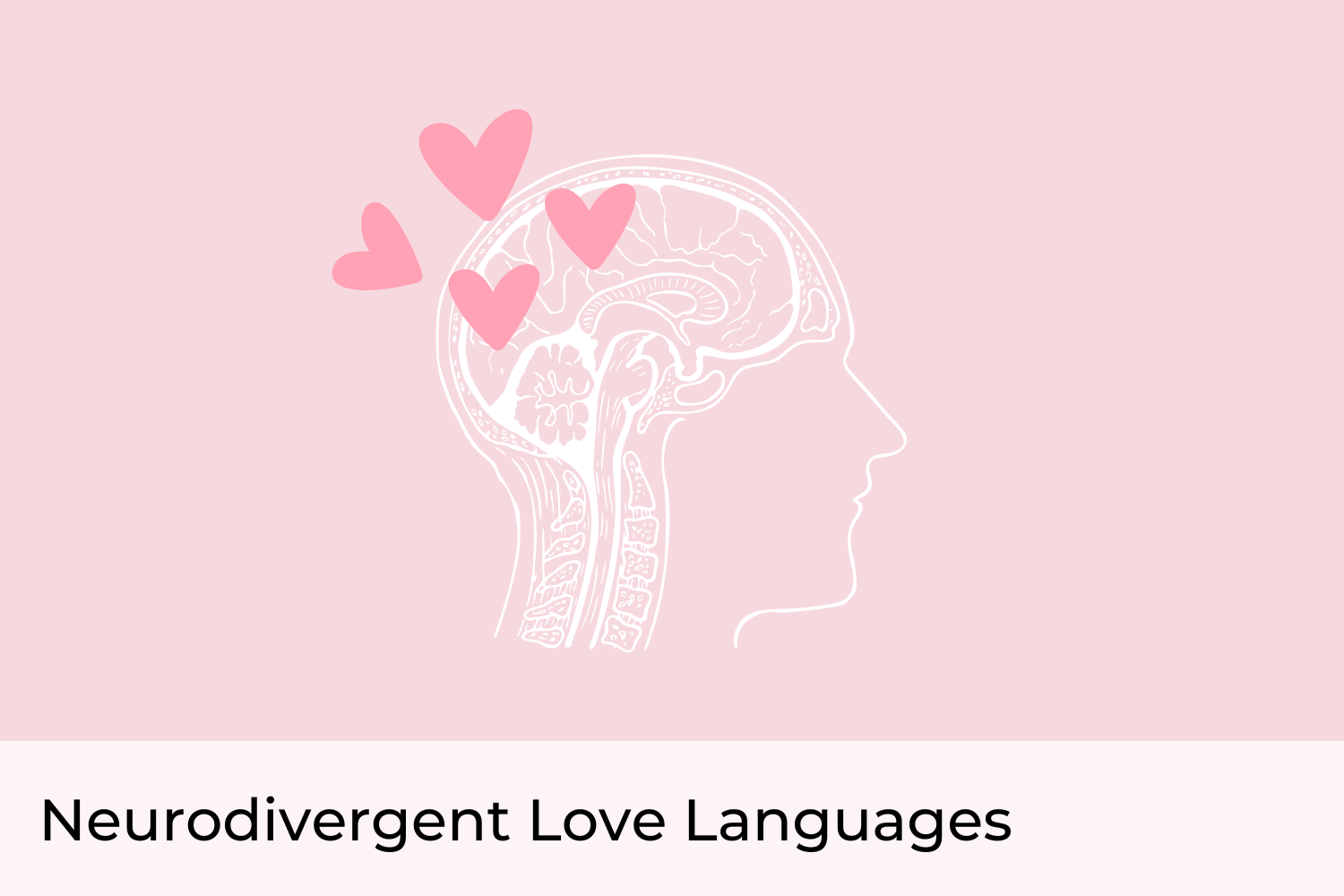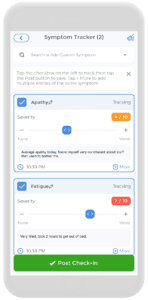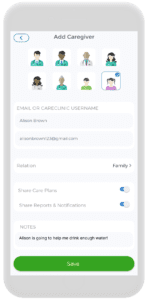
Humans are social creatures. We thrive in companionship and wilt in isolation. We prioritize our relationships, and friendships and surround ourselves with conceptions of love and partnership. In fact, according to a study done by Al-Khalili et al. in 2012, the phrase “what is love” has been the most searched phrase across internet search engines.1 What is very clear, however, is the fact that love has no definition and looks different from person to person. In 2010, a book by Gary Chapman highlighted what he then called “The Five Love Languages: The Secret to Love That Lasts”. 1 These neurodivergent love languages provide an answer to what love looks like for various individuals.
But what if those individuals don’t necessarily fit the societal norm? Perhaps they are neurodivergent and experience the world and their experiences in a unique way. For neurodivergent individuals living in a neurotypical world, feeling understood and included is difficult. In fact, many people believe the love languages of neurodivergent individuals are different from that of neurotypical. Thus, over time these love languages have been adapted into what are now the 5 neurodivergent love languages to better fit the demographic. When it comes to your relationship, using a tracker app to understand which of the 5 neurodivergent love languages fits you best can help you cultivate, strengthen and better understand what you require from the people in your life.[1][2]
Defining Neurodivergence
Neurodiversity
It’s no secret that each of us is unique in our own ways. We learn at different paces and can look at one painting and see 2 different things. Essentially, to be neurodiverse simply means to develop and operate in a way that is distinctive to you.1 The term is inclusive, recognizing and alluding to the different variations we see in people everyday2. For example, perhaps an autistic child might be what seems like a natural at reading, while you took much longer to develop that skill as a child. Many of us are able to recognize that this difference is not negative at all – there’s simply a variation in how the 2 people developed, but neither would be considered abnormal.
Neurodivergent Symbol
While neurodiversity alludes to inclusivity, to be neurodivergent is much more exclusive3. In fact, a person who is neurodivergent is defined to be differently abled than most other people or compared to what is considered to be the societal norm4. In simple terms, being neurodivergent pretty much means that the difference in your brain changes the way you understand goes about the world. 2 Holistically, a neurodivergent person’s cognitive profile is just different than the average persons4. And that’s okay! In fact, if there is one thing you should take home from this message, it’s this: being divergent is not a negative thing. Not in any sense of the word.
Many neurodivergent people have incredible abilities: they can be better at visualization, have outstanding memory and be more creative than the average individual2. For example, the autistic child we described earlier would be considered neurodivergent – they were gifted with the ability to learn reading much easier than the average child.
The neurodivergent symbol demonstrates and summarizes this concept really well. The neurodivergent symbol is composed of a rainbow infinity sign on a white background. This rainbow features a variety of different colors against a relatively plain and monotone background, symbolizing the diversity among people who are neurodivergent.
Neurotypical
Being neurodivergent is the complete opposite of neurotypical. I’m sure just by reading the word you can already guess what it means. Neurotypicality essentially refers to everyone who isn’t neurodivergent. That is the individuals who do not demonstrate any differences in their brain function, strengths, or weaknesses2. The way they process and understand the world and their experience is much closer to what is established to be the average experience3. I repeat being neurodivergent is simply the opposite of neurotypical![3][4][5]
Being Neurodivergent: A Quick Review
Symptoms of Neurodivergence
Being neurodivergent isn’t a diagnosable disorder. In fact, the term isn’t official or recognized at all in the medical community. Instead, you can think of the term as more of a self-proclaimed label to help understand and comprehend an individual’s differences in a rather neurotypical society. As a result, there’s a large variability seen in individuals who identify as neurodivergent.
Despite this discrepancy, there are many disorders that are generally considered to be neurodivergent. One of the most widely accepted of these disorders is autism disorder. Autism is considered a spectrum disorder: this means there are various ways the disorder can present. Each can be very different from the others, with different symptoms and behaviors. Despite this, everyone with varying presentations will still be considered neurodivergent, as their brain functions, strengths and weaknesses are comparable, different from the norm. They simply differ in different ways.
As follows from this example, being neurodivergent doesn’t come with a checklist of symptoms. There really are no all-encompassing diagnostic criteria to be deemed neurodivergent. Instead, people who are neurodivergent are indeed unique from the norm but can also be quite different from each other. On the other hand, some neurodivergent people can also be quite similar to each other.

Using CareClinic to Find out if you are Neurodivergent
Being neurodivergent is hard to determine. However, using a health app, such as CareClinic, to keep track of your symptoms, experiences and how you manage your day-to-day life can help you determine if you have a certain neurodivergent disorder or neurodivergent tendencies. For example, by using the symptom tracker, you will be able to record periods of time where your moods are highly elevated, and periods where it is quite low. As such, the app provides a comprehensive snapshot of your health to help you determine if you have any corresponding disorders – such as bipolar, ADHD or anxiety.
Neurodivergent Conditions
Generally, conditions that are considered to be neurodivergent can be classified into 3 broad categories: applied, clinical and acquired.
Applied Neurodivergent Conditions
Applied neurodiversity includes non-health-related congenital conditions such as 5
- Dyscalculia – Difficulty with mathematical and numerical concepts5
- Dyslexia – Difficulty in language, reading, and writing5
- And dyspraxia – Difficulties in relation to movement5
Clinical Neurodivergent Conditions
Contrastingly, clinical neurodiversity encompasses health-related conditions and the individual born with5. Some common clinical conditions include:
- Attention Deficit Hyperactivity Disorder (ADHD) – A developmental condition affecting concentration, attention span, and impulsivity5
- Autism – A spectral condition generally affecting communication, social behavior, impulsivity, and sensory processes5
- Tourette Syndrome – A nervous system disorder, causing uncontrollable, repetitive motions or sounds, more commonly referred to as ‘ticks’5
Acquired Neurodivergent Conditions
Acquired neurodivergent conditions are, well they’re acquired! These conditions include those that occur as a result of a health condition or external event5. Some such examples include:
- Acquired brain injury – Brain damage caused by an external accident implicating mental capability5
- Illness – Generally affecting the nervous system5
- And mental health – Conditions affecting cognition and mental well-being5
What is a Love Language?
I’m sure many of us, myself included, are guilty of doing a love languages quiz online. In researching for this article, I redid a love languages quiz to refresh on what I am classified as. I’ve had my friends try and guess what I would be and vice versa. There certainly is an appeal to knowing your love language and using it as a defining characteristic of your personality, whether you determine it through an online quiz or real-life experiences. You can also learn and do a neurodivergent quiz here as a bonus. But what really is a love language and what does it entail?
According to Gary Chapman, a marriage counselor with 30 years of experience and a man who is widely accredited with bringing the theory to life, language is the way a person expresses and receives love1. It is the manner in which a person ‘speaks’ and understands adoration and emotion. For example, one person might need physical touch to feel loved by another or demonstrates their care by providing a service to the person. Overall, your love language encompasses how you express your love and care for another person, whether it be a family member, friend or significant other, and how you prefer to be loved by them1.
Emotional Bid: The Currency of Connection
When we crave attention and connection, we tend, as humans, to put out some signal or sign. Whether it be communicating through words, facial expressions, or text, we let the people around us know that we desire that love and care from them.
It is this signal that is referred to as an emotional bid6. In the same way that a photo is made up of pixels, or a puzzle is constructed from its pieces, these requests for connection are the fundamental and central unit of emotional communication in every kind of relationship – romantic, social and professional6,7. Often, these bids are subtle6. People aren’t necessarily good at vulnerability. If you were to outright state you want attention and it is not received, the rejection would feel a lot worse than if you were to simply stretch out your hand6.
An emotional bid can be big, small, nonverbal, or verbal6. At the end of the day, these bids are what allow us to make reasonable adjustments to ensure that our partners meet our needs. They are the pixels of relationship communication that lie at the heart of the 5 neurodivergent love languages6.
The Benefits of Understanding Love Languages in a Relationship
The core of Chapman’s belief surrounded what he described as a ‘love tank’8. By speaking each other’s love language, partners can fill each other’s tanks and have a more satisfying relationship. In his experience, partners that consciously decide to show love in their partner’s preferred language will be in the happiest of relationships8.
But what everyone really wants to know is if putting in this effort and learning these languages is worth the effort. In theory, it appears to work, but where is the proof? In a 2018 study, a survey posed 5 questions to 38 participants following participation in the love language program9. Moreover, in accordance with this study, using love languages appears to increase empathy in relationships and help in understanding the other person’s perspective. Also, love languages help you better understand yourself and why you do the things you do. Thus, you tend to gain a better grasp of yourself as an individual9.
These benefits are universal but can become especially relevant when you consider the varying function of a neurodivergent individual. People who are neurodivergent tend to express themselves differently. Thus, they require different things as compared to the 5 love languages proposed by Chapman. As love languages do appear to increase relationship empathy and perspective, along with the acceptance of oneself, it is important to have a similar construct that can be applied and inclusive toward a neurodivergent individual as well. Resultantly, we now have what is referred to as the 5 neurodivergent love languages.[6]
The 5 Neurodivergent Love Languages
Infodumping
The first of the 5 neurodivergent love languages, infodumping is essentially talking about an interest or passion in detail and at length 7. Sharing this information is your form of expressing your emotions.
The term and idea come from the tendency of autistic individuals to develop a ‘special interest’, or SpIn. Autistic individuals do characteristically have a tendency to develop an obsession with something very specific. While some SpIns last a lifetime, others are short-lived. Having a SpIn is a vital part of the autistic culture and is oftentimes a source of joy and happiness. As such, encouraging someone to discuss their SpIn with you is a sign of care and friendship. By encouraging others to talk – infodump – about their special interest, you are demonstrating autistic empathy and autistic love7.
Parallel Play/Body Doubling with ADHD
The second of the neurodivergent love languages is parallel play. Parallel play, also known as body doubling, can be something as simple as just existing together7. The idea is that you spend quality alone time with each other, doing either the same, or different tasks. One person could be playing a game, while another is reading a book. Or maybe both are reading a book. Regardless, the idea is that you spend time alone, but in the company of the other person as a sign of care.
Oftentimes parallel play doesn’t require continual conversation. However, it is always nice to share stories and take the time to reflect on what the other is saying. In this way, the other person knows you are there, you are present, and you are listening7. You provide them with the attention they desire and show your love in that way.
Parallel play does come from the ADHD practice of sitting with a person with ADHD as they tackle a task on hand7. In this way, they find they are held accountable and can stay focused on their task for longer. You don’t need to help them or step in, for someone with ADHD, hard work is just easier and more fun with someone sitting nearby7.
Support Swapping

The next neurodivergent love language is known as support swapping. This term essentially refers to the practice of accommodating and supporting people who are neurodivergent7. They keep each other accountable and help us stay on the right track. Say for example, as a neurodivergent person you struggle with drinking enough water every day or taking your medication. Perhaps your friend sends you reminders or sets up a chart for you to keep track of your water intake or medication. Or vice versa. Maybe they help you with your water consumption and you help them with their homework. Regardless, support swapping is just that – swapping different forms of support that each person needs. The person tells you what they need and you either fill that gap or find someone else who can7.
Using the CareClinic app can help you support swap with the My Care Team feature. This feature allows you to add individuals to your team, so they are able to have access to your trackers and actively help you stay on track with your help. Continuing with the water example, they can ensure you are drinking enough water and send you a reminder if they see that you haven’t. Similarly, you can ask to be added to their Care Team to return the support – effectively support swapping! The My Care Team feature makes speaking this love language easier and a lot more accessible! If there is someone else that needs help and prefers an offline solution, consider a printable caregiver daily checklist.
Deep Pressure
You can think of deep pressure as a weighted blanket or a baby swaddle. Especially for people with anxiety, feeling squeezed or under deep pressure helps relieve the anxiety and, in the case of a weighted blanket, helps them sleep. Scientifically speaking, a good, tight hug does provide proprioceptive input and soothes the body’s stress response7.
Over time, tolerating this pressure does grow and you likely would need as intense of a squeeze. In fact, many people report that with regular exposure to the stimulus, you find yourself calming down, and becoming more comfortable with less pressure.
Giving someone a massive, firm, bear hug can be especially helpful if their neurodivergent love language is under deep pressure. And the role works both ways! Asking for that tight squeeze or making the people in your life aware that it is something you require, can help them know how to best aid you in recognizing you are loved and cared for7. Though, you should always make sure you ask or give consent beforehand.
Penguin Pebbling and Autistic Love
The name for this love language comes from the tendency of penguins to give small pebbles to other penguins that they care about7. It’s their sign of affection and love.
Similarly, this neurodivergent love language refers to unconventional gift-giving. Sharing something you think would make the other person laugh – like a meme – or giving them something you know they care about. Penguin pebbling is finding a pink rock on your daily walk and bringing it back to your roommate because you know they love the color pink.
Penguin pebbling also relates back to the concept of SpIns in autistic individuals. By giving them something that reminds you of their SpIn, you are both encouraging them and making it known that you are inviting them to share more about it. In this way, you are demonstrating a form of autistic love that they will better understand than a conventional love language.
The moral here is whether it is a meme, a button, or something as random as a pen you picked up from a convention, you’re telling the other person “hey, I thought about you today and thought you would like this”. It’s a little ‘thinking or you’ pebble7.
Finding Your Neurodivergent Love Language

Finding your neurodivergent love language can sometimes be as easy as taking a quiz online. Others may decide to reflect on their past experiences to draw conclusions about what they find most heartwarming. The Care Clinic app can make this process easier for you by providing a platform on which you can record your experiences and events in your life and reflect on how you feel in the moment and what that could mean. For example, using the diary function to write down an incident where your significant other brings home a flower, they know is your favorite can help you determine that your neurodivergent love language is penguin pebbling.
Additionally, the CareClinic app also encompasses a symptom and mood monitor that can help you determine if practicing these love languages has an impact on how you are feeling in your day-to-day life. Maybe you have implemented these love languages, like info dumping, but don’t know if it has been helping you feel more loved and cared for. Well, looking at the reports chart feature in the app can help you recognize trends and patterns that correlate to when you started consciously using a love language. This can help you draw conclusions on what works best for you.
The Care Clinic app is an all-in-one step forward in understanding the neurodivergent love languages that fit your best. Using the app can help you find what makes you feel the happiest and loved. The app can help support your relationships, friendships, and social ability to ensure you are always happy, healthy, and safe in your relationships.
References
- Surijah, E. A., & Septiarly, Y. L. (2016). Construct Validation of Five Love Languages. Anima Indonesian Psychological Journal, 31(2), 65-76. https://doi.org/10.24123/aipj.v31i2.565
- Cleveland Clinic. (2022, June 02). Neurodivergent. Retrieved from: https://my.clevelandclinic.org/health/symptoms/23154-neurodivergent
- Centre for Addiction and Mental Health. (n.d.). Career Burnout. Retrieved from: https://www.camh.ca/en/camh-news-and-stories/career-burnout
- Legault, M., Bourdon, J-N., & Poirier, P. (2021). From neurodiversity to neurodivergence: the role of epistemic and cognitive marginalization. Synthese, 199, 12843-12868. https://doi.org/10.1007/s11229-021-03356-5
- Skelling, J. (2019). Neurodiversity: An overview. The Education Hub. Retrieved from: https://theeducationhub.org.nz/wp-content/uploads/2020/06/Neurodiversity-An-overview.pdf
- Stimpunks Foundation. (n.d.). Emotional Bid. Retrieved from: https://stimpunks.org/glossary/emotional-bid/
- Boren, R. (2022, January 22). The Five Neurodivergent Love Languages. Stimpunks Foundation. Retrieved from: https://stimpunks.org/2022/01/22/the-five-neurodivergent-love-languages-2/
- Chapman, G. (2007). The five love languages: How to express heartfelt commitment to your mate. Chicago, IL: Northfield Press.
- Nichols, A., Riffe, J., Kaczor, C., Cook, A., & Crum, G. (2018). The Five Love
Languages Program: An Exploratory Investigation Points to Improvements in Relationship Functioning. Journal of Human Sciences and Extension, 6(3), 3. https://doi.org/10.54718/VBDZ5406
References
- “The Five Love Languages”. https://en.wikipedia.org/wiki/The_Five_Love_Languages
- “Love Languages Actually Do Improve Your Relationship”. https://time.com/6189958/love-languages-improve-relationship/
- “Neurodiversity | Definition, Movement, & Affirming | Britannica”. https://www.britannica.com/topic/neurodiversity
- “Neurodivergent: What It Is, Symptoms & Types”. https://my.clevelandclinic.org/health/symptoms/23154-neurodivergent
- “Neurodivergent symbol: The Rainbow Infinity Sign”. https://holistarx.com/neurodivergent-symbol/
- “What are The 5 Love Languages?”. https://5lovelanguages.com/learn/


